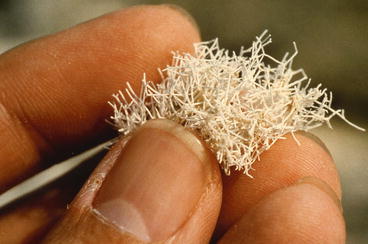(1)
Hand Surgery Department of Clinical Sciences, Malmö Lund University Skäne University Hospital, Malmö, Sweden
Abstract
The hand is a sensory organ as important as the eye and ear. The sense of touch is essential for exploring the surrounding environment, and the tactile sensibility of the hand easily identifies textures and shapes. Without tactile sensibility, the hand loses most of its function. Hand sensibility can replace vision in complete darkness. Vision shows us the shape of objects, while the sense of touch confirms the impression and gives a more complete picture of its consistency, hardness, material properties and texture, even on the backside and inside – seeing is believing, but touching is understanding. While the hand’s tactile sensibility is essential in most everyday tasks, protective sensibility is essential to avoid harmful burns and wounds. Sensory feedback is essential for regulating grip force. A body part that loses sensation and sensory feedback triggers a lost sense of ‘body ownership’ – it is no longer perceived as part of the body. Congenital insensitivity to pain is a very uncommon illness found among some families, especially in northern Sweden.
Calling the hand a sense organ may sound strange since it is usually the eye or the ear that are regarded as obvious sense organs. Touch is but one of our five senses, the others being sight, hearing, smell and taste. Problems with vision and hearing are somewhat common, but problems with hand sensibility are not equally well known. We take it for granted that the tactile sensibility in our hands will always be good and that our hands will function normally. We expect our hands to be able to estimate the temperature of the water in the shower by just feeling the stream. With our sense of touch, we can decide whether a shirt is made of cotton or synthetic material, and we can estimate the character and structure of the textile by feeling its texture. With our fingers, we easily detect tiny scratches as well as small crumbs from bread and grains of salt on the breakfast table, and we have no problem handling a fork and knife or a drinking glass or picking up a lump of sugar even if our sight never leaves the text in the morning paper.
But if the fingers lose their sensibility, they also lose their fine motor properties. Everyone who has lost feeling in their fingers on a cold winter day knows that it can be totally impossible to grip a key and lock the door. A hand without sensibility is usually also a hand without function.
The sense of touch and the fine sensibility of the hand makes it a sense organ, equally important as the eye and ear [1–3]. We are dependent on hand sensation in most activities of daily life in our homes, at work and at leisure. And of course when we spend time together with our family and closest friends, how would we be able to caress the hand and cheek of our loved ones with a hand without sensation?
Normally hand sensibility and vision cooperate and interact when we experience the world around us, but in certain situations, hand sensibility plays a crucial role. When there is a sudden power failure at home on a dark winter night, our hands immediately take on the role of feelers towards the surroundings. Without vision we grope along walls and well-known features of our home until we ultimately find a drawer, explore its contents and identify a candle and a match to light it – not an easy task for two hands in total darkness.
The hand is a master when it comes to finding and identifying objects in total darkness. One dark evening in September, I finally reached the mountain lodge I was hiking to on a rainy day in the mountains of northern Sweden and could finally take off my backpack. There was no electric light in the cabin and no paraffin lamp. I had to quickly pick up a change of clothes from the deep layers of the backpack – socks, underwear, a shirt and a sweater. My hand searched in complete darkness and had no difficulty identifying and picking up all these objects: In the darkness my hand could ‘see’ what was hidden. My hand could easily differentiate between stockings, socks and shirts, and it was irritated by non-visible small scraps from a damaged package of biscuits in the bottom of the sack.
The role and importance of the sense of touch and the tactile sensibility of the hand has been described in a very poetic, sensitive and accurate way by the Swedish poet, novelist and 1974 literature Nobel Prize Laureate Harry Martinson in his poem ‘Human Hands’ from 1971, published in the poem collection Dikter om ljus och mörker (poems about light and darkness):
The experience of hands is tactile.
Their life among things is manifold,
filled with silent contents.
They do not hear, but sense vibrations.
They do not see, but know how it is in dark cellars,
when velvet is to be valued they are there,
and silently they test the grindstone and the scythe’s edge.
No need to let the edge bite down.
With a light touch they feel the steel’s sharpness.
How have they found time to collect all their fine experiences
of wool and gravel, of down and steel,
of smooth surfaces and prickly thistle-heads,
of supple talcum and of every kind of flour.
Their range is immense
from shiny silk to coarse sacks,
from rough files and graters
to the smooth nails of the new-born
and the touch-shine on everlasting flowers.
They live in the land of feeling where touch is everything
and where the mystery of touch is the bridge between nerve and soul.
But they find their limit in the scales of the butterfly’s wing.
Translated from the Swedish by Judith Moffett and Lars-Håkan Svensson
In poetic colours, Martinson describes the sense of touch and the inborn potential of the fingertips’ fine-tuned sensitivity. The sensory experience is based on the accumulated knowledge and previous experiences of the hand; recognising shapes, an item or the character of a texture requires memories of earlier sensory experiences – the experience of hands is tactile. The hands’ abilities are based on ingrained programming to perceive and understand forms and textures, a learnt capacity to estimate and perceive shapes and forms, which dates back to the newborn child’s first exploration of its nearest environment. The newborn child uses all of its senses and the most sensitive parts of its body, its lips and hands, to explore and touch the shapes and textures of items. Sensory and visual inputs interact, and experiences and memories are collected by simultaneously touching, observing, tasting and smelling objects in the vicinity, forming the basis of a lifelong ability to perceive and understand forms and shapes.
Vision and touch interact effectively when exploring the environment; hearing and touch have much in common – They do not hear, but sense vibrations. Hearing and tactile sensibility are based on vibrations transmitted via a tympanic membrane (hearing) or via irregularities of the fingerprint ridges inducing vibrations when the fingertips are moved across an irregular surface. Martinson is well aware that tactile sensibility is based on vibrations, even if it is a matter of silent vibrations.
Martinson also describes how the sense of touch guides us when we proceed in darkness – They do not see, but know how it is in dark cellars. With the fingers we feel irregularities of the rough walls in dark cellars, perhaps defects in the paint and perhaps also the moisture of the mortar. The hands even feel the stickiness and the faint elasticity in the fine threads of a network of cobwebs. The hand can ‘see’ around corners, and both hands simultaneously ‘look’ in various directions when we find our way in the darkness.
Martinson describes the immense range and the hands’ ability to recognise and feel the character of textures: Their range is immense. Through the sense of touch, we experience the character of wool and gravel, down and steel, even supple talcum and every kind of flour. The sense of touch makes it possible to differentiate various surfaces and textures, everything from coarse sacks and rough files to shiny silk and the smooth nails of the newborn. The sense of touch makes it possible to judge the quality of cloth and textile: When velvet is to be valued they are there. Martinson puts a limit on the sensitivity of the hand: But they find their limit in the scales of the butterfly’s wing.
The ability to feel the structure and character of a texture can be especially important in certain occupations. Vera, aged 65, has worked at a hand bookbinding company for most of her life. I get in touch with her because I need to recondition a copy of Charles Bell’s The Hand, its Mechanism and Vital Endowments, a seminal work from 1834 about the anatomy of the upper extremities of various animal species, and the role of the hand as a sense organ in man. Unfortunately, the binding had come apart and several pages were loose. Stroking her fingertips over the paper and the bindings, Vera tells me how she can tell simply by touch the quality and thickness of various sorts of paper and how calfskin, goatskin and whale skin bindings differ in terms of roughness, friction, suppleness and elasticity. Her hands’ ability to experience all this had disappeared some years earlier when she developed carpal tunnel syndrome (a nerve entrapment at wrist level), but the tactile sensibility of her hand recovered following a simple surgical procedure decompressing the nerve.
Martinson also touches on another important sensory function in the hand: sensation as a protective mechanism to avoid hand injuries. Prickly thistle-heads can injure the hand, but the pain sense warns and puts a limit on what the hand can tolerate. The sharpness of the scythe’s edge can be anticipated without the hands being hurt by the sharpness. The sense of touch and pain interact to protect the fingers: No need to let the edge down. With a light touch they feel the steel’s sharpness.
Martinson is aware that the hands represent a link between body and soul, especially regarding feelings and tactile discrimination. He writes of the hands: They live in the land of feeling where touch is everything and where the mystery of touch is the bridge between nerve and soul. He knows that it is not always easy to differentiate between tactile sensitivity and feelings. To be touched can be a matter of touching the heart rather than touching the skin, and a touching experience leaves an imprint on the soul rather than on the hand. To lack the right feeling indicates a lack of insight and understanding. In intimate social interactions, touch is a basis for tenderness and solidarity. A touch of hands represents friendship, love, sensuality, affection and sexuality.
In Anglo-Saxon literature, the word touch is used in many contexts in the border zone between tactile sensibility and feeling [2–4]. Let’s stay in touch has a deep meaning in terms of continuing contact, interaction and solidarity. To find an event touching is an experience that touches the heart.
Tactile sensibility and feelings interact in the contact between hands. Contact between hands represents security, and a friendly or tender touch of the hand creates a feeling of comfort. The skin possesses a special system of thin nerve fibres that react to slow stroking and caresses, transmitting a feeling of comfort, pleasure and delight. Such nerve fibres do not project to the usual areas of sensory input in the brain cortex, but rather to the limbic system, an area of the brain that is associated with feelings of enjoyment and comfort [5]. It is well known that skin-to-skin contact, not least caresses and contact between hands, can induce such effects. This may explain the beneficial effects of ‘tactile massage’ and the calming effect that hand contact and stroking over the back of a hand may have in states of unease and anxiety, especially in elderly people.
The feeling of pleasure associated with skin stimulation and the touch of hands may be associated with a release of the hormone oxytocin. Oxytocin was first described in breast-feeding mothers, but it is present in all of us and plays an important role in the feeling of well-being associated with hand contact between individuals as well as stroking the fur of animals. The release of oxytocin is stimulated not only by body contact but also by other pleasant experiences like sun, warmth, pleasant music and enjoyable moments with friends. Oxytocin stimulates the limbic system – the brain’s ‘reward system’ – and thus may stimulate feelings of enjoyment and pleasure
The Seeing Hand
The refined sensibility and delicate motor functions of the human hand make it an extension of the brain towards the outer world; Immanuel Kant even called the hand ‘the outer brain’. The tactile sensibility gives ‘eyes’ to the hand, creating the ability to produce an inner true picture of the environment through the act of touch [3, 6, 7] (Fig. 7.1).
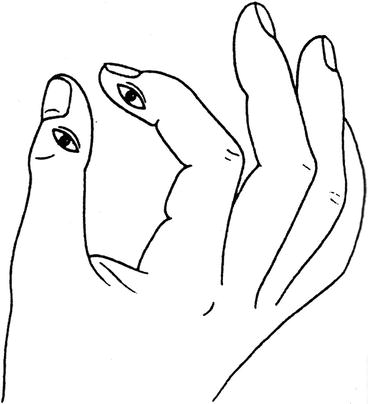

Fig. 7.1
Seeing fingertips (From Erik Moberg Akut handkirurgi; Lund 1969)
David Katz (1884–1953), an authority in the field of perception psychology, had a specific interest in the interaction between hand sensibility and sight [2]. Katz describes how the eye can see the outer characteristics of objects, while the hand can see the inner characteristics. Touch tells us the true character of an object: Sight reaches the surface and gives us an impression of the shape, while touch confirms the perception and creates a full picture of the object’s consistency, hardness, material properties and dexterity, even on the backside and inside (Figs. 7.2, 7.3, 7.4, and 7.5). The sense of touch helps us to understand and explore the vicinity: ‘seeing is believing, but touching is understanding’ (Fig. 7.6).
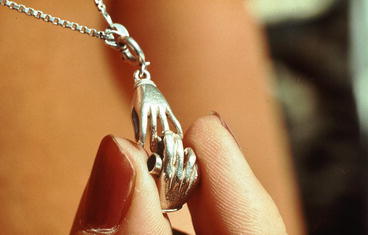
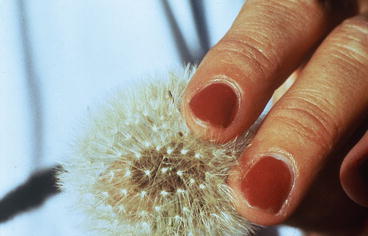
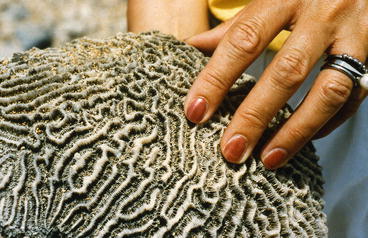

Fig. 7.2
The tactile sensibility of fingertips makes it possible to perceive the shape and texture of small objects

Fig. 7.3
With fingertips we can perceive the fine structure of a dandelion seed head

Fig. 7.4
With the fingertips we can feel the finest detail of a coral’s superficial pattern (From Lundborg [13])

